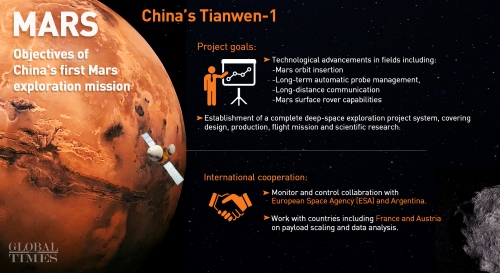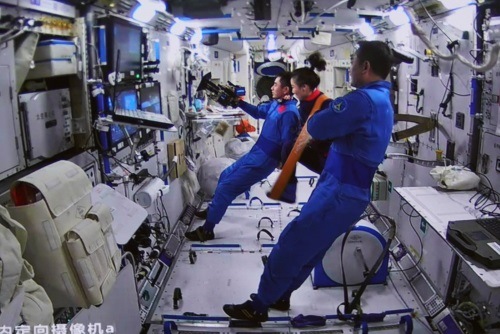China is rapidly emerging as a formidable force in the global space race. With ambitious plans for lunar and Martian exploration, Beijing seeks to position itself as a dominant player in space science and technology.
Recently, the China Manned Space Agency (CMSA) unveiled logos for three significant missions scheduled for 2025: Shenzhou XX, Shenzhou XXI, and Tianzhou 9.
These missions are part of a broader strategy under China’s National Space Science Medium and Long-Term Development Plan, which aims to surpass the United States as the leading space power.
| Notes : The China Manned Space Agency (CMSA) is the organisation in charge of China’s human spaceflight program. Formed in 1992, it manages missions like the Shenzhou spaceflights, astronaut training, and the development of China’s Tiangong Space Station. The agency also plays a key role in lunar and Mars exploration. Looking ahead, CMSA plans to expand China’s space capabilities, including a possible crewed mission to the Moon. |
How many types of spacecraft have been used and what are its objectives?
Here are the key details about the mission name and its objectives.
| Mission | Type | Objective |
| Shenzhou XX | Crewed spacecraft | Transport astronauts to the Tiangong Space Station for advanced research. |
| Shenzhou XXI | Crewed spacecraft | Conduct experiments aboard Tiangong and enhance space station operations. |
| Tianzhou 9 | Cargo spacecraft | Deliver supplies, fuel, and equipment to support space station functionality. |
These missions will strengthen China's foothold in maintaining and advancing its Tiangong Space Station, which serves as a hub for long-term human presence in space and scientific innovation.
What are the Strategic Ambitions Dominance Beyond the Earth?
China’s long-term vision, outlined in the National Space Science Medium and Long-Term Development Plan, reflects its determination to secure a leading position in space exploration.
The strategy is structured into three stages:
- Phase 1 (2023–2027):
Focus on developing core technologies, including unmanned lunar exploration and Mars mission preparation. - Phase 2 (2028–2035):
- Land taikonauts on the Moon and establish a permanent lunar research base.
- Execute complex manned Mars missions.
- Preliminary groundwork for deep-space missions.
- Phase 3 (2036–2050):
- Dispatch manned missions to celestial bodies such as asteroids and the moons of other planets.
- Solidify leadership in space science innovation.
What are China’s Lunar Aspirations and Resource Utilisation?
China’s lunar exploration program is a cornerstone of its space ambitions. The International Lunar Research Station (ILRS), planned for the Moon’s South Pole, is designed to serve as a transit hub for deep-space missions and a site for exploiting lunar resources such as helium-3, a potential fuel for clean nuclear fusion.
What are the Key Milestones for the China Space Mission?
- Chang’e 6 Mission (2024): Sample return from the Moon’s far side.
- Chang’e 8 Mission (2028): Site selection for the lunar base.
- First Crewed Lunar Landing (2030): Demonstrating the capability for sustained human presence on the Moon.
The Moon’s proximity to Earth, availability of water ice, and lack of atmosphere make it an ideal location for testing deep-space technologies and as a staging point for Martian exploration.
Mars: The Next Frontier
China’s Martian ambitions began with the Tianwen-1 mission in 2020, which successfully landed a rover on Mars. The upcoming Tianwen-3 mission (2028) aims to return Martian soil samples to Earth by 2030, ahead of NASA's timeline. These efforts pave the way for a crewed Mars mission by 2031, a critical step toward establishing a sustainable presence on the Red Planet.

Source: Global Times
China’s focus on developing technologies like Martian regolith-based construction materials and advanced life-support systems underscores its commitment to long-term habitation on Mars.
What are China's Strategic Implications in this Space Mission?
China’s advancements in space are driven by more than scientific curiosity. They align with its broader geopolitical objectives:
- Technological Leadership: Establishing supremacy in cutting-edge technologies, including reusable launch systems and satellite constellations.
- Economic Benefits: Spurring innovation in clean energy, advanced materials, and robotics.
- Military Advantage: Enhancing capabilities in space-based surveillance, communication, and defence.
- Global Influence: Positioning itself as a leader in international space collaboration through initiatives like the ILRS.
What are the Challenges faced by China Space to Achieve the missions?
Despite its ambitious plans, China faces significant challenges:
- Funding: Sustaining the high costs of space exploration.
- Space Debris: Mitigating risks associated with increasing orbital debris.
- International Competition: Navigating competition with NASA, ESA, and private entities like SpaceX.
- Collaboration Limitations: Overcoming restrictions on partnerships with key global players such as the United States.
What are China's Growing Space Ambitions?
The unveiling of these logos is symbolic of China’s broader goals in space exploration, which include:
- Strengthening Space Station Operations: Tiangong has become a central pillar of China's manned space strategy, showcasing its capability to independently develop and manage orbital research platforms.
- Expanding Scientific Research: The missions aim to advance scientific discoveries in fields such as astrophysics, robotics, and life sciences.
- Competing on a Global Stage: By consistently launching missions, China positions itself as a key player in the global space race, vying with agencies like NASA, ESA, and private entities like SpaceX.
What are China's Future Prospects?
China’s space program continues to gain momentum, yet it faces challenges such as ensuring sustainable funding, mitigating space debris, and fostering international collaboration. Despite these hurdles, the consistent pace of development reflects its resolve to remain a dominant force in space exploration.
According to China Manned Space Engineering Network, “Since successfully completing the first extravehicular activity on December 17, 2024 Beijing time, the Shenzhou 19 astronaut crew has successively completed the inspection and maintenance of equipment in the space station, full system pressure emergency drills, preparations for the second extravehicular activity, etc., and the experimental projects in the fields of space materials science, space life sciences, aerospace medicine, etc. have been steadily progressing.

Source : China Manned Space Agency/ Xinhua
At present, the Shenzhou 19 astronaut crew is in good condition, the space station complex is operating stably, and will carry out the second extravehicular activity at an appropriate time in the near future.
In conclusion, China’s space program is a testament to its growing technological and geopolitical aspirations. Through well-defined strategies and sustained investments, Beijing is on course to redefine the global balance of power in space. While the journey is fraught with challenges, its focus on lunar and Martian exploration, combined with technological innovation, positions it as a serious contender in the 21st-century space race.
For more updates on Space related information & news stay tuned!
Comments
All Comments (0)
Join the conversation